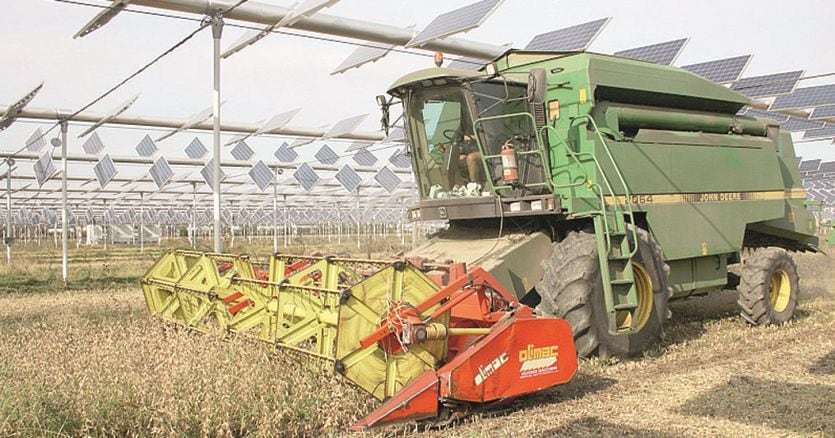Above, a system patented by the Remtec company, with photovoltaic modules over four meters high, which changes its position according to the shading needs of the plant. Below, corn crops, which according to studies carried out with the University of Piacenza grow by 4.3% more than in open fields. But also lettuce and rows of vines, both with growth of between +15 and +30% according to internal studies, as well as soy (+10%), endive, cabbage, tomatoes and wheat. The agrivoltaic field of Borgo Virgilio (Mantova) houses 7,680 panels on 11 hectares. Here, since 2011, the coexistence of photovoltaics and crops has been experimented, a synergy that translates into well-being for plants and a production of clean energy that exceeds 3.3 million kilowatt hours per year. But this plant is neither the only one in Italy nor the only possible model.
Breakthrough year
To name a few, at the end of 2022 the Mase (Ministry of the Environment) gave a positive opinion on a 37.6 megawatt agri-voltaic plant that Marco Polo Solar intends to build in the Foggia area. The 9.7 megawatt agri-voltaic park of Renantis in Scicli (Ragusa) should be operational by March. Remtec itself has two other plants in the Piacenza area, one in China and one in France, two in Japan, and in 2023 it is expected to complete another six: in Portugal (for Galp Energia) and Emilia-Romagna on vineyards, in France on paddy field (for Edf), in Lombardy on cereals and fodder.
2023 could be the turning point for agrovoltaic, starting with the implementing decree that will release the Pnrr funds, expected shortly. It is a question of 1.1 billion euros for the «Sviluppo agrovoltaico», which sets the goal of installing plants for 1.04 gigawatts by 2026, with an expected production of around 1,300 gigawatt hours per year. The declared objective is to reduce the energy supply costs of the agricultural sector, which today exceed 20% of company costs, and improve its climatic and environmental performance, with a potential reduction of 0.8 million tons of CO2. In detail, the funds should include non-repayable contributions of up to 40% for the construction of the plants defined as advanced agri-voltaic systems (see the fact sheet on the page).
The models
“Different models are being developed in Italy: on the one hand we find complex experimental systems that integrate photovoltaic modules mounted on very tall and often sparsely arranged structures, on the other hand systems that use consolidated technologies such as single-axis tracking trackers”, explains Rolando Roberto , engineer and entrepreneur in the field of renewables, CEO of Aedes Group Engineering and among the protagonists of the panels dedicated to agriculture at Fiera Agricola Tech, the event dedicated to technological innovation in agriculture (1 and 2 February at Veronafiere). «Depending on the type of cultivation, the most suitable solution will have to be studied to ensure optimal energy and agricultural yield», he continues. According to Roberto, it is necessary to have “a long-term vision, because the incentives of the Pnrr will be sufficient to finance just one gigawatt of plants, compared to the 80 necessary to cover the national objectives”. Moreover, according to estimates by Legambiente, Greenpeace, Italia Solar and WWF, to achieve the photovoltaic objectives in 2030, it will be necessary to intervene on 50-70 thousand hectares of agricultural land.
«Agrovoltaic is an added value for agriculture – explains Giancarlo Ghidesi, vice president of Aias (Italian Sustainable Agrivoltaic Association), coo of Remtec and speaker at Fieragricola Tech. “It is the way to produce clean energy, which also serves to decarbonise the sector without losing hectares of land, thanks to plants raised above the ground that allow extensive and mechanized agriculture without disfiguring the landscape”. Ghidesi hopes that, in the decrees implementing the tender for Pnrr funds, a system will emerge that does not relegate the agricultural entrepreneur to a tenant, but makes him the protagonist of this transformation process. And that the implementing decrees direct the funds only towards plants which, in the guidelines of the Mite, are defined as advanced.
